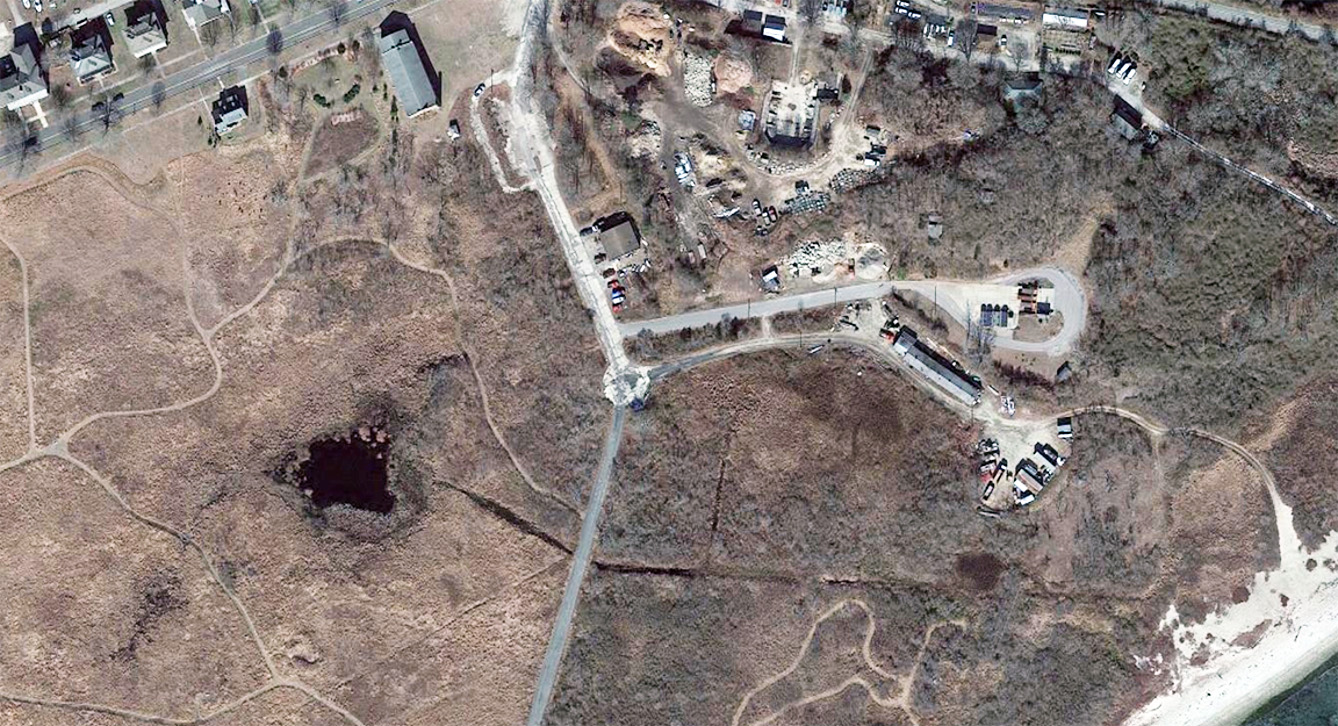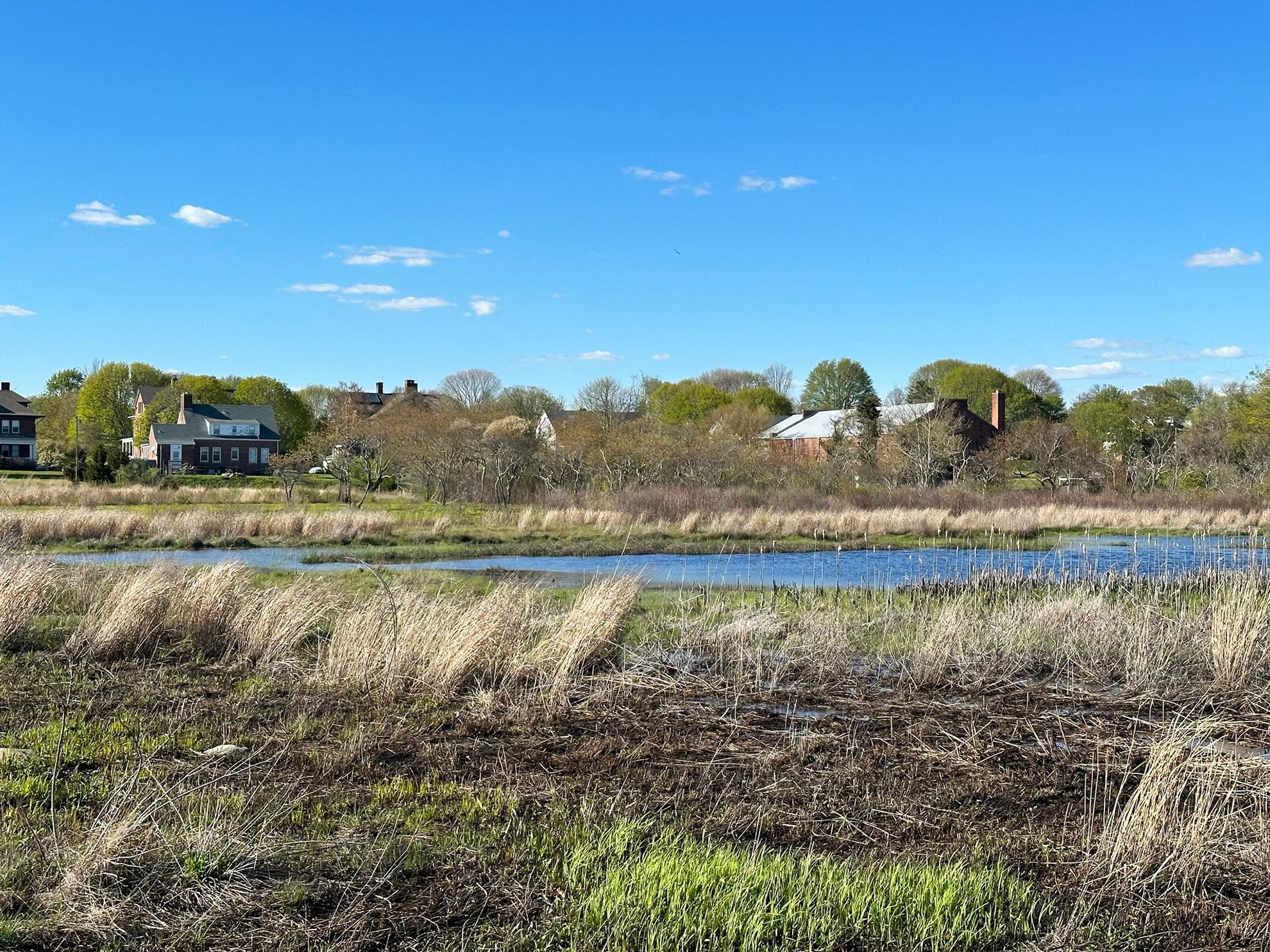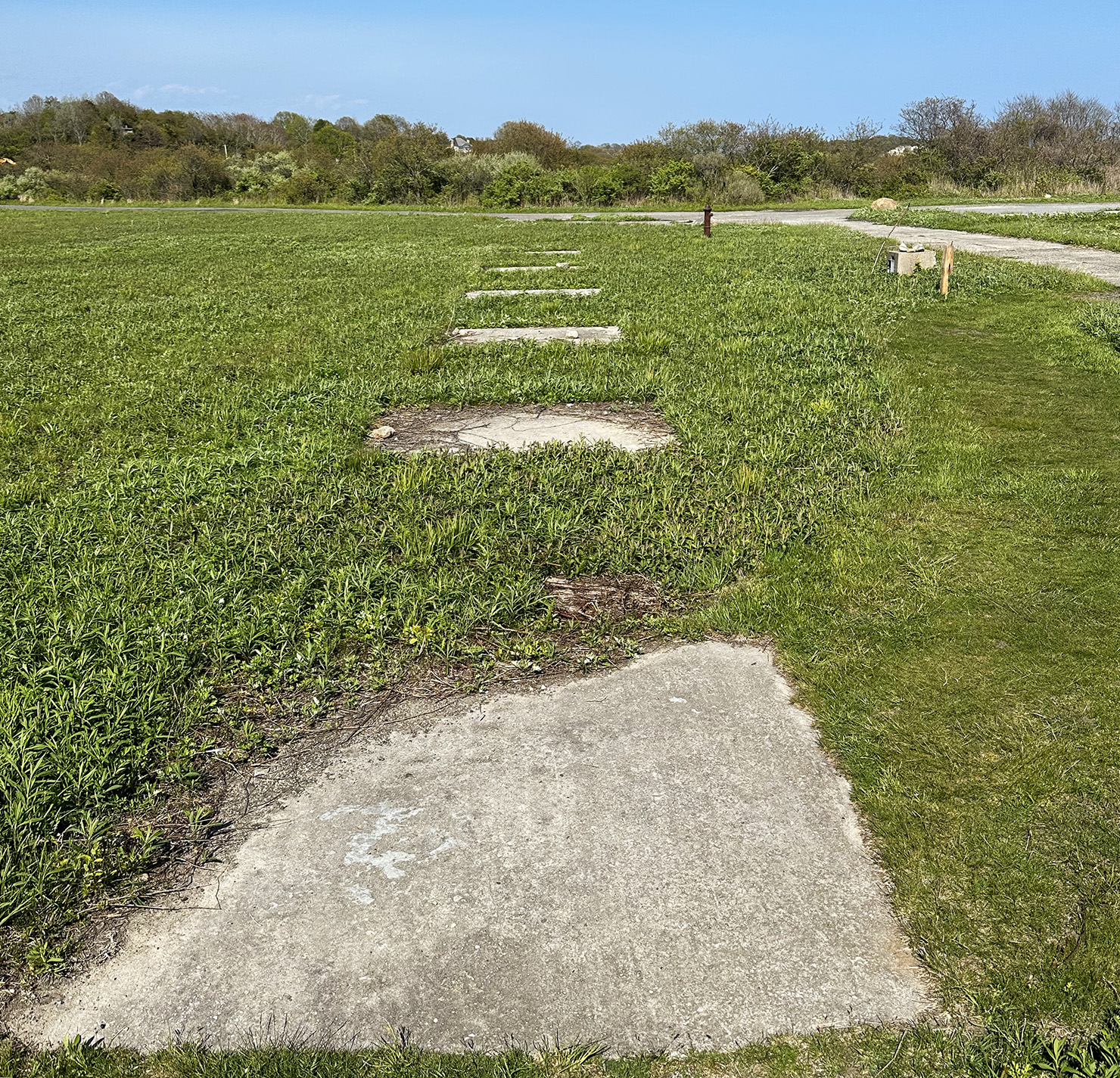Island History
by Pierce Rafferty
Aerial showing eastern edge of former Fort H.G. Wright parade ground. Photo courtesy of Google Earth. The pond at center left, originally named “Lake Ladd,” was later nicknamed “Movie Pond.” Note the ditch, first cut by the US Quartermaster Corps circa 1908, that utterly failed to drain the pond. Remarkably, a simple rail line was also established by the military to haul sand from South Beach for the sole purpose of filling in the pond.
While first constructing Fort H.G. Wright in the early 1900s, the US Army’s Quartermaster (QM) Corps initiated a major campaign to drain and fill in wetlands throughout the Fort property. It was estimated that there were twenty ponds of fresh or brackish water on the acquired land, measured at one million square feet, along with 20 to 25 acres of marsh that provided optimum breeding areas for mosquitos. The QM Corps, assisted by teams of hired Italian laborers, attempted to eradicate the offending water bodies, swamps, and wetlands by cutting ditches and filling the targeted sites with dirt and sand taken from leveled hills and gun emplacement pits.
However, not all ponds at the Fort were easy to eradicate. One that survived was located southwest of today’s movie theater. It was originally named “Lake Ladd” on military maps in honor of the QM Corps captain named Ladd who had been tasked with filling it in. Fed by groundwater springs, this water body defied repeated attempts to wipe it from the landscape. Edwin Horning (2019-2008), F.I. School teacher, naturalist, and Museum curator, chronicled the rich natural diversity of “Movie Pond” in his booklet Birds, Plants, & Fish of Fort H.G. Wright that was published in 1998. Sadly, the diversity he celebrated appears to have significantly diminished in the ensuing decades, mirroring nationwide declines in bird and amphibian populations.
Movie Pond
by Edwin Horning
Movie Pond is located across the road from the osprey nest, behind the Movie Theater. You can also reach it by going from the Ferry Dock to the eastern end of Whistler Avenue and turning right onto Town Road just past the Movie Theater. It is about 100 yards south on the right.
Movie Pond, though small, has a cast of thousands. It is a freshwater pond, never more than 4 feet deep, which becomes a dry mud flat during most summers. During the winter it is sometimes covered by ice thick enough to walk on. As Movie Pond warms, and winter turns into spring, the very first sound of life is the “peep peep” of the spring peeper, Hyla crucifer, one of the tree frogs. At first one or two, then an entire chorus is heard in late March. After mating rituals, hundreds of eggs are laid; they later become tadpoles, and later still, frogs. They supply food for birds such as herons, that visit the pond. During August, on rainy nights, hundreds of peep frogs appear on the pavement in front of the Movie House, and also on walls. I once was surprised to see one on our television screen.
During April, ducks begin to fly into the pond. Small numbers of mallards and black ducks appear, and occasionally, green-winged teal and blue-winged teal. Sometimes a flock of glossy ibises circle, land, and feed in the pond. Also during April, male red-winged blackbirds arrive; about a month later the females appear. Some will mate and nest in the area.
In May, the chorus of the peeper frogs is often joined by Virginia rail, and sometimes the “peent, peent” call of the woodcock is heard. The Virginia rail has nested in the broadleaved cattails at the southeast edge of the pond. Later, in July and August, adult and young Virginia rails may be seen at the pond if one is quiet and lucky, for rails are extremely shy birds, more often heard than seen. On July 9, 1994, a very foggy day, at 9:00 AM, I made my way through the surrounding grassland to the pond. I was very surprised to see a large rail and two small “fluffs” near the cattails. I thought “king rail!” Moments later this thought was confirmed, when another rail with two fluffs appeared. The large rail was the king rail with her young and the smaller one the Virginia rail with her young. The king rail is very rare. This was the only time that I ever found it at the pond.
At least one pair of muskrats inhabit the pond and may be seen once in a while. Sometimes a food storage den, made mostly of cattails, may be seen in the pond. During the summer as the pond dries, muskrat trails in the mud can be seen.
After mid-July, several species of herons visit the pond to feed on peep frog tadpoles, and perhaps small water insects. Most likely the herons come from South Dumpling Island where they nest. Herons seen are the great blue heron (the largest of the herons), little blue heron (the adult is bluish, but immatures are amazingly white and difficult to distinguish from the two white herons, the great egret, and the snowy egret). The snowy egret has a black beak and golden feet. The great egret has a long yellow beak. Two other herons that appear in July are the green heron and the black crowned night heron. The most distinguishing field mark of the green heron is its long reddish brown neck; the black crowned night heron has a white breast and very black brow. At the same time, we can see the glossy ibis, an unmistakable, dark reddish-brown bird with a long, curved beak. All of these begin to appear in the pond in July, with more coming in August.
Appearing at the Movie Pond in late June and early July are the shorebirds that nested in the far north and are now migrating southward. The first to arrive is the tiny and brownish least sandpiper, the smallest of the sandpipers. The advance guard of three to five birds are often first seen at Airport Beach. They appear at Movie Pond after the water level has lowered enough to leave mud flats.
Next to arrive are the dowitchers, larger pigeon-sized brownish shorebirds with long beaks; they jab at the bottom under the water for food with a sewing machine action. The greater and lesser yellowlegs (recognized by their long yellow legs and long bills) arrive in August. Near mid-August, some of the rarer sandpipers arrive. One of these is the solitary sandpiper, with a pronounced white eye-ring. As the name implies, it is usually seen alone, although on rare occasions as many as four may be seen together. Another is the stilt sandpiper, which looks like a dowitcher but has a rusty cheek patch and a slightly more slender bill. A rarer bird is the Baird’s sandpiper, that looks much like a semipalmated sandpiper, but a little bigger. They usually appear alone and mingle with the other sandpipers. In 1995, a single Baird’s sandpiper arrived at the pond on August 17, when there was still water in the pond, and remained until the pond was completely dry on August 26. It was the last sandpiper to be seen on the mud flats of the pond during the summer of 1995. The semipalmated sandpiper, the second smallest, arrives in late July, four or five birds at first, and later as many as 40-50. It looks much like a least sandpiper, but is bigger, grayer, and has a broader beak.
Four other sandpipers have been seen at Movie Pond. They are the sanderling, the pectoral sandpiper, the spotted sandpiper, and the common snipe. They are all migrants from the north, except the spotted sandpiper, which nests on the Island. The spotted sandpiper is the only one with spots on its breast. It walks with a peculiar bobbing manner. It is never seen in greater than 4-5 family-sized groups. The sanderling is medium-sized and is the whitest of the sandpipers. It is never seen in numbers of more than 5 at the pond. The pectoral sandpiper is larger than the sanderling and has a sharp division between its white belly and brown-striped breast. Only one or two are seen at a time. The common snipe looks much like a woodcock but with a white stripe running along the center of its head. I have seen these rarely, usually a single bird at the edge of the pond.
Three species of plovers visit the mud flats of the drying pond. The smallest and most abundant is the semipalmated plover. “Semipalmated” means that has small webs between its toes, visible only if you have one in your hand. It is nearly the size of the semipalmated sandpiper, with a shorter bill and a bar across its white breast. As many as 20-30 may visit the pond at one time. The black-bellied plover is much larger and has its black belly only in the spring. In August, it has a whitish belly, a gray back and a short bill. Only one or two of these are seen at a time. Many more may be seen at the Airport Beach. Another familiar plover at the pond is the killdeer.
Wilson’s phalarope has been seen only once at Movie Pond. This bird has a very thin beak and swims buoyantly in the water in a spinning manner.
Beginning in late July or early August, dragonflies are seen flying back and forth across the pond catching smaller insects such as mosquitoes. Sometimes a pair of dragonflies flies over the pond in tandem, every so often dipping down to the water. There the female deposits eggs. Sometimes the female flies alone dipping to the water surface to lay her eggs. There are two groups of dragonflies, the darners and the skimmers. Of the darners, the most abundant are the green darners. Among the skimmers are the ten-spot, the golden wings, the whitetail, the red saddlebags, the wandering globetrotter, and perhaps others. All are very colorful and fascinating to watch as they glide over the pond.
Now, a brief description of the plant life in and around the pond. Along the path to the pond is grassland, the main species being switch grass or Panicum virgatum. Here and there among the switch grass are sedges (Carex). The stems of sedges are triangular while those of grasses are round. There are goldenrods that have yellow flowers beginning in August. It is in this field that one of our native orchids, the ragged fringed orchid, thrives among the grasses.
At the edge of the pond are typical wetland plants. One of these is bur-reed, Sparganium americanum. On this plant are separate male and female flowers. The female flowers are large green spheres about ¾ inches in diameter, while the males are small, about ¼ inch in diameter. There are members of the rush family, such as the Canada rush Juncus canadensis, and members of the sedge family, some of which are the American bulrush, Scirpus validus, wool grass, Scirpus cyperinus, and species of the spike rush genus Eleocharis. The broad-leaved cattail grows in clumps along the edge, providing a home for the Virginia rail. In August, the pond is bordered by a member of the buckwheat family, a smartweed called mild waterpepper.
Leaving the pond, walking through the small grassland, you pass through a small thicket. If it is September, you may see a small flock of bobolinks perched on shrubs of the grassland. The thicket is made up of small black cherry trees, with an understory of bayberry, autumn olive, Japanese honeysuckle, bittersweet, wineberry, and others. In summer in this thicket you can see such Island nesting birds as the yellow warbler, the common yellowthroat, the kingbird, the redwinged blackbird, the house sparrow, and the song sparrow. In the autumn, you can see swamp sparrows in the grass, white-throated sparrows, phoebes, yellow-rumped warblers; near the pond I have seen the rare Lincoln’s sparrow.
After leaving the thicket, turn right on Town Road. If you pass the grassland along the north side of the road in April and May, look for blue violets. If you walk into the grassland near the pond you will find the white lance-leafed violet.
Continue southward on Town Road and take the first turn to the right. You will see a large thicket on the left, a place where the members of the National Guard pitched their tents on large cement platforms.
Former Fort Wright tent platforms south of Movie Pond, May 10, 2023.
Photograph by Pierce Rafferty.




